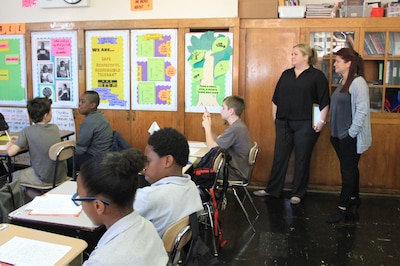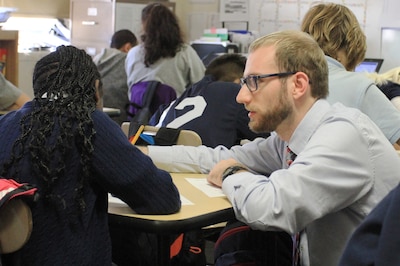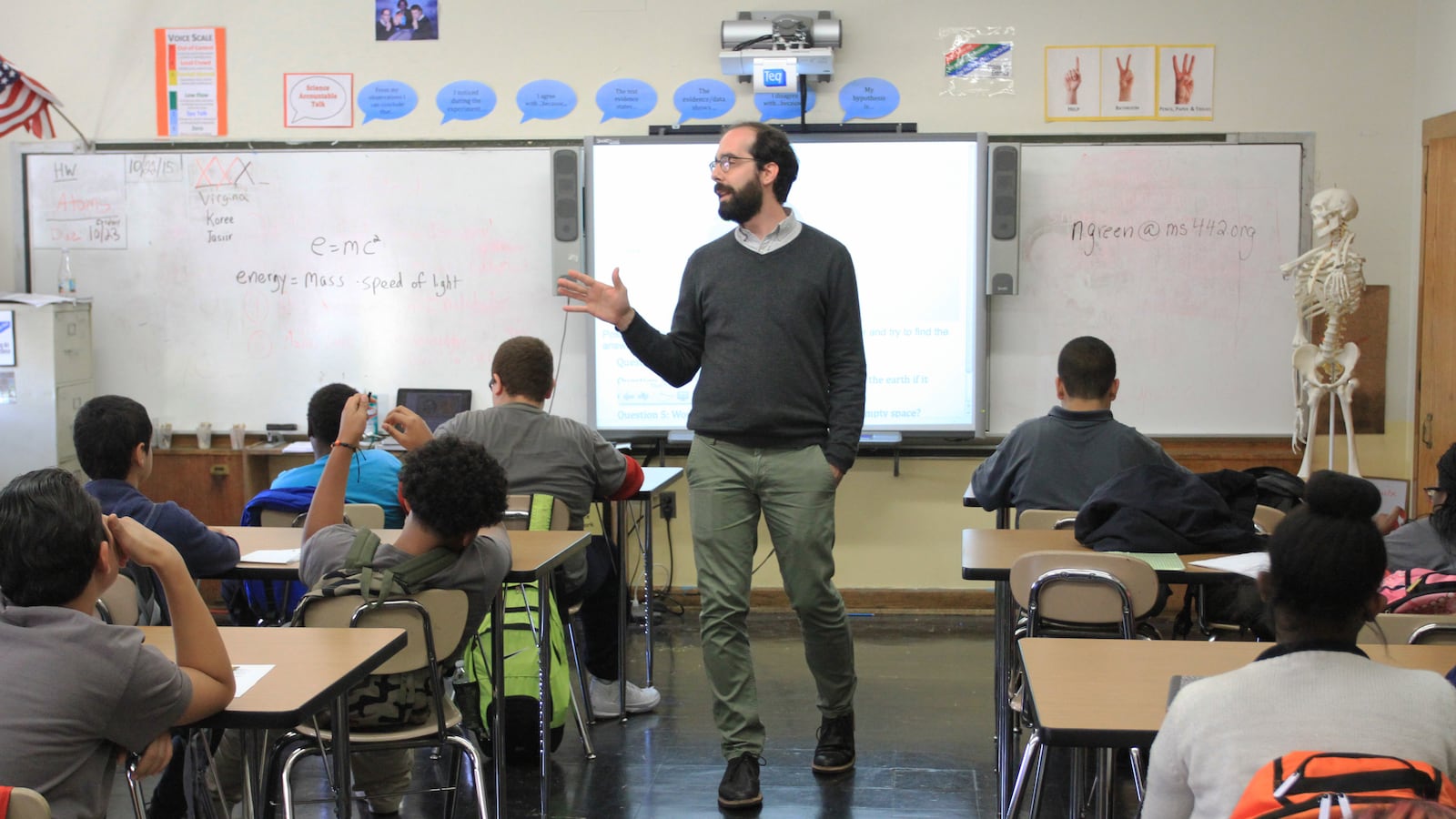When Deanna Sinito first landed a job at a Carroll Gardens middle school in 2007, she saw a lot of things the school needed to change — including its name.“New Horizons School” didn’t sound like a middle school, she said. It sounded like “a rehab center.”
“It wasn’t a bad school, but it wasn’t necessarily somewhere I would send my child,” said Sinito, who became the school’s principal in 2009 and led its transformation until taking a district leadership position in August. “The academics weren’t there.”
The school, located just a few blocks south of the Gowanus Houses, is now called the Carroll Gardens School for Innovation. It has changed so dramatically in recent years that people familiar with Brooklyn’s District 15 say the school feels like a different place.
“Now it’s a school that people are asking for,” said Anita Skop, the district superintendent. “It is considered by the chancellor to be one of her hidden gems.”
As part of our Raise Your Hand series, Chalkbeat is answering reader questions including one from a city staffer who wondered: “How do you remove a long-standing negative reputation from a school?”
Answering that question isn’t easy. Freeing a school from a lackluster reputation tends to take major, perceptible changes in a school’s management and culture. And, in gentrifying neighborhoods like Carroll Gardens, it means making those changes known to new families in hopes that they’ll take a chance on the school.
The School for Innovation has been able to do both of those things.
Its leaders spent years overhauling what happened inside classrooms, partly through intensive teacher training. They used the extra funds the schools receives for its large population of students with special needs to lower class sizes — and to put two teachers in every classroom.
Then, the school opened its doors to local parents and boosted its outreach efforts to compete with other schools in the area.
“We really took a good hard look at what we were doing,” Sinito said, adding that there had been “a lot of hand-holding, coddling and low-expectations” with the students, almost all of whom were black or Hispanic.

Today, the school has moved up on many parents’ lists of desired middle schools in the competitive district. It has been cited by Apple for its use of technology. The city has included the school on its list of noteworthy “showcase schools,” and gave it top marks on its most recent evaluation.
Improvements in the classroom have led to demographic changes that have accelerated the pace of change, creating a virtuous cycle of improving test scores and reputation among parents. In that way, the School for Innovation is a case study of the kind of school transformation championed by Chancellor Carmen Fariña, who insists that schools must woo new parents from the outside even as they improve instruction on the inside.
Classroom-level changes
Sinito’s first order of business was to make sure she had the right staff in place, she said.
That meant having difficult conversations with a handful of teachers who were encouraged to move on. They were carefully replaced with new staffers who said they were willing to push students further academically than they were used to.
“There’s a grey area when you’re working with such needy students to only support them social-emotionally and give them the minimum,” Sinito said, noting that around 40 percent of the school’s students have special needs and that many struggle with the challenges of poverty. “We needed to up the standard.”
With her core team of teacher leaders in place, the next focus was curriculum.
The school moved toward project-based learning, brought in Teachers College to improve English instruction, and created a math coach position.
School leaders focused on teacher training and creating teacher leaders. Five teachers have attended week-long seminars at Apple in California, costing $5,000 per teacher, to learn about integrating technology into the classroom. Classrooms were more frequently broken up into small groups of students.
On a recent morning, for example, a seventh-grade science class had nine students working with one teacher to better understand a math concept, while 12 other students sat at desks doing independent work.

“We were always very good at supporting our low-level learners, our struggling learners,” said Noreen Mills, the school’s current principal, who has worked at the school since it opened in 1998. The school had never paid too much attention to its high-performing students, she added, but “that’s different now.”
Attracting new parents
But even as changes were happening inside classrooms, it took an entirely different type of push to have the school slowly start to be recognized by parents seeking top performing schools for their children.
“A reputation of a school is a hard thing to overcome,” Sinito said. “We knew that we were changing, but the community didn’t really see it that way. They were not giving the school a shot.”
So in 2010, they stopped calling the school “New Horizons.” By 2012, the staff had decided on its current name.
“It made people come in and tour,” Sinito said. “I don’t think it was just the name, but I think the idea that it’s a new place gave people the OK to come in and see what was going on inside.”
And with the middle school application process underway this fall, the interest is evident. Nearly 500 people attended open house sessions at the school over the last two weeks, said Ed Castro, the school’s parent coordinator. The school has had full tours of 35 people for the last four weeks and has had to schedule another five to accommodate the demand, he added.
Applications have increased, too, by nearly 40 percent over the last few years. Nearly 500 students applied to join the school’s sixth-grade class this fall, which ended up accepting 77 students.
With that, the student population has started to change.
For years, the school’s demographics had held constant: Nearly 50 percent of its students were Hispanic, about 40 percent were black, and about 7 percent were white. Many of the students lived in public housing like the Gowanus Houses and few came from the wealthy and gentrifying blocks that now surround the school.
The newer, more affluent families had avoided the school until the last year or two. Now, the school is much more diverse. Today, 20 percent of the school’s students are white and 25 percent are black. Hispanic enrollment has remained relatively steady.
Officials say that diversity is good for the school and the community, making the school more representative of the district as a whole.
“We have some great schools in District 15 and parents are really starting to see that now,” Skop said, adding that families are becoming more “sophisticated” in looking beyond the handful of middle schools with the highest test scores. “That diversification of options also leads to diversity at those schools… All children benefit from a good educational climate.”
Work in progress
Arelie Ibarra, a Sunset Park mother-of-two, considers the School for Innovation one of her top choices for her 10-year-old son, Jesus, to attend next year.
Ibarra said she was drawn to the school’s small class sizes, after-school programs, and the fact that every class has two teachers — an ideal situation for her son who has special needs and has been diagnosed with a speech impairment.
“He’s not aggressive and he follows rules, but he needs a small environment,” she said of her son who is a fifth-grader at P.S. 58 in Carroll Gardens. Ibarra said she hopes the collaborative teaching and small classes will help wean her son off of two private tutors — one for math, and another for reading and writing.
But in a district that includes some of the city’s wealthiest neighborhoods like Park Slope and Boerum Hill, many parents remain skeptical. The district boasts some of the highest test scores in the city — some schools had 75 percent of their students pass state English and math tests last year, more than double the citywide average — and many parents won’t consider a school without a longstanding track record of high performance.
“We would not consider any school that is low-level,” said Florence Carrie, whose son is also a fifth-grader at P.S. 58, but previously attended a private school in Manhattan through second-grade.
For parents like Carrie, a school in transition like the School for Innovation might be a tough sell — at least for now. While the school’s scores have improved, they still lag behind district and city averages. In 2015, 18 percent of students passed the state English exams, compared to 8 percent in 2014. In math, the pass rate shot up from 5 to 13 percent.
“It has made significant improvements,” said Skop, the superintendent. “It’s a very funny thing — people go by what they hear and what their friends say and what they heard five years ago. Sometimes school rumors just don’t change in a timely manner.”

